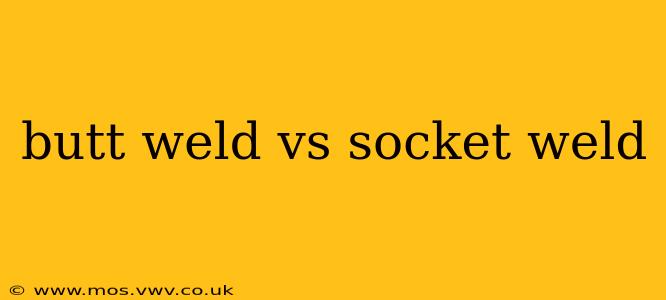Choosing the right type of weld for your piping system is crucial for ensuring safety, reliability, and longevity. Two common methods are butt welds and socket welds. Understanding their differences is vital for making informed decisions. This comprehensive guide will delve into the specifics of butt welds and socket welds, highlighting their advantages, disadvantages, and ideal applications.
What is a Butt Weld?
A butt weld is a type of fusion weld where two pipe ends are joined directly, creating a continuous, seamless joint. The weld is typically made using a welding process such as Gas Tungsten Arc Welding (GTAW), Gas Metal Arc Welding (GMAW), or Shielded Metal Arc Welding (SMAW). Proper preparation of the pipe ends, including beveling and cleaning, is crucial for achieving a strong and reliable weld.
Advantages of Butt Welds:
- High Strength: Butt welds offer superior strength and durability compared to socket welds, making them suitable for high-pressure and high-temperature applications.
- Smooth Internal Surface: The smooth internal surface minimizes turbulence and pressure drop within the pipeline.
- Suitable for Large Diameters: Butt welds are readily used for joining large-diameter pipes.
- High Integrity: When properly executed, butt welds provide a high degree of structural integrity to the pipeline.
Disadvantages of Butt Welds:
- More Complex Preparation: Preparing pipe ends for butt welding is more time-consuming and requires specialized skills and equipment.
- Higher Skilled Labor Required: Butt welding requires highly skilled welders to ensure a quality weld.
- More Expensive: The increased complexity and labor requirements translate to higher costs compared to socket welding.
What is a Socket Weld?
A socket weld involves inserting one pipe end into the socket of a fitting. The weld is then made around the outer perimeter of the pipe within the fitting's socket. This type of weld is commonly used with smaller diameter pipes and fittings.
Advantages of Socket Welds:
- Faster and Easier: Socket welding is generally faster and less complex than butt welding, requiring less preparation and skilled labor.
- Less Expensive: Lower labor costs and simpler preparation contribute to lower overall costs.
- Suitable for Smaller Diameters: Socket welds are particularly well-suited for smaller diameter pipes.
Disadvantages of Socket Welds:
- Lower Strength: Socket welds generally have lower strength compared to butt welds, limiting their application in high-pressure systems.
- Potential for Internal Grooves: The weld geometry can sometimes create internal grooves, potentially leading to turbulence and pressure drop.
- Limited to Smaller Diameters: The socket weld design is not practical for larger pipes.
Butt Weld vs. Socket Weld: Key Differences Summarized
| Feature | Butt Weld | Socket Weld |
|---|---|---|
| Joint Type | Continuous, seamless | Pipe inserted into fitting socket |
| Strength | Higher | Lower |
| Preparation | More complex | Simpler |
| Cost | More expensive | Less expensive |
| Skill Level | Requires highly skilled welders | Requires less skilled welders |
| Diameter | Suitable for all diameters | Primarily for smaller diameters |
| Internal Surface | Smooth | Potentially grooved |
Which Weld is Right for Your Application?
The choice between a butt weld and a socket weld depends on several factors, including:
- Pressure and Temperature: Butt welds are preferred for high-pressure and high-temperature applications due to their superior strength.
- Pipe Diameter: Socket welds are typically used for smaller diameters, while butt welds are suitable for all diameters.
- Cost Considerations: Socket welds offer cost savings in terms of labor and preparation.
- Weld Accessibility: In situations where access is limited, socket welds might be easier to perform.
Consulting relevant codes and standards, such as ASME B31.1, is crucial for making the correct selection for your specific project.
What are the different types of butt welds?
There are several types of butt welds, differentiated by their preparation and welding process. These include single-V butt welds, double-V butt welds, single-U butt welds, double-U butt welds, and J-butt welds. The choice depends on the thickness of the material being welded and the desired weld profile. Each type requires specialized welding techniques and skill to ensure a strong and reliable connection.
What are the limitations of socket welds?
While socket welds offer simplicity and cost-effectiveness, they are limited in their application. Their lower strength restricts their use in high-pressure and critical systems. Additionally, the potential for internal grooves can create flow restrictions and reduce the overall efficiency of the pipeline. The limited size range also restricts their usefulness to smaller diameter pipes.
How do I choose the right welding process for butt welds?
Selecting the appropriate welding process for butt welds depends on several factors, including material type, thickness, accessibility, and desired weld quality. Common processes include Gas Tungsten Arc Welding (GTAW), Gas Metal Arc Welding (GMAW), and Shielded Metal Arc Welding (SMAW). Each process has its own advantages and disadvantages, and choosing the right one requires expertise and knowledge of the specific welding application.
This guide provides a comprehensive overview of butt welds and socket welds. Remember that proper welding techniques and adherence to relevant codes and standards are critical for ensuring a safe and reliable piping system. Always consult with qualified professionals for any complex welding projects.
